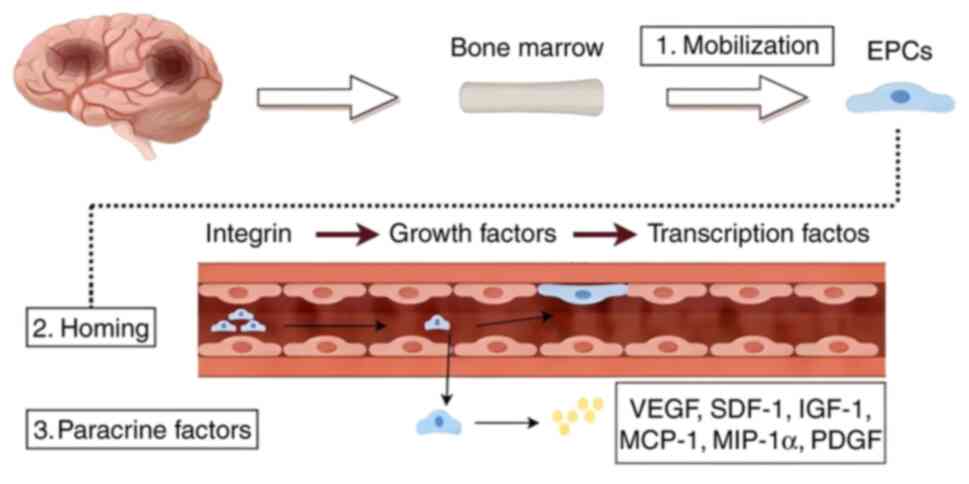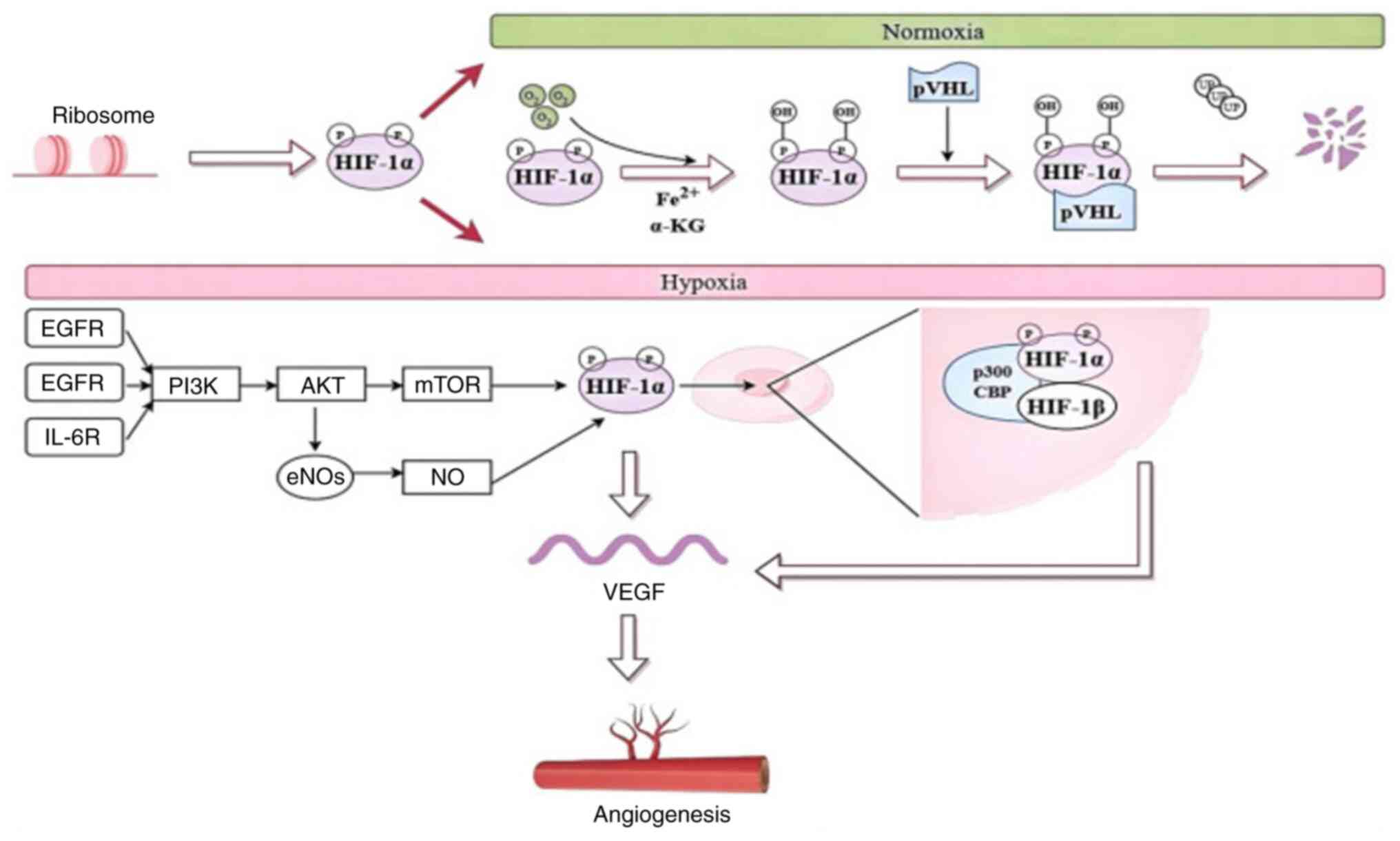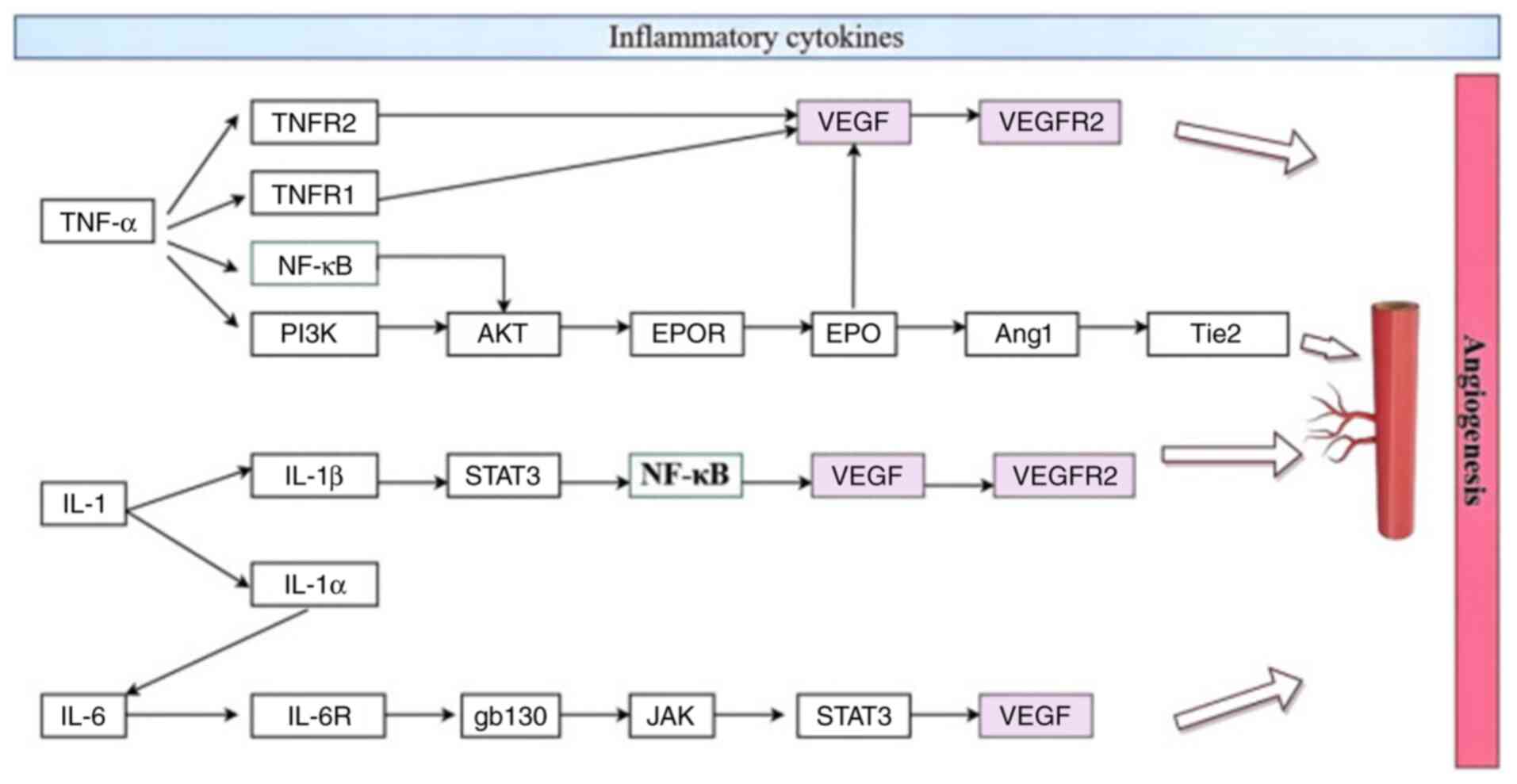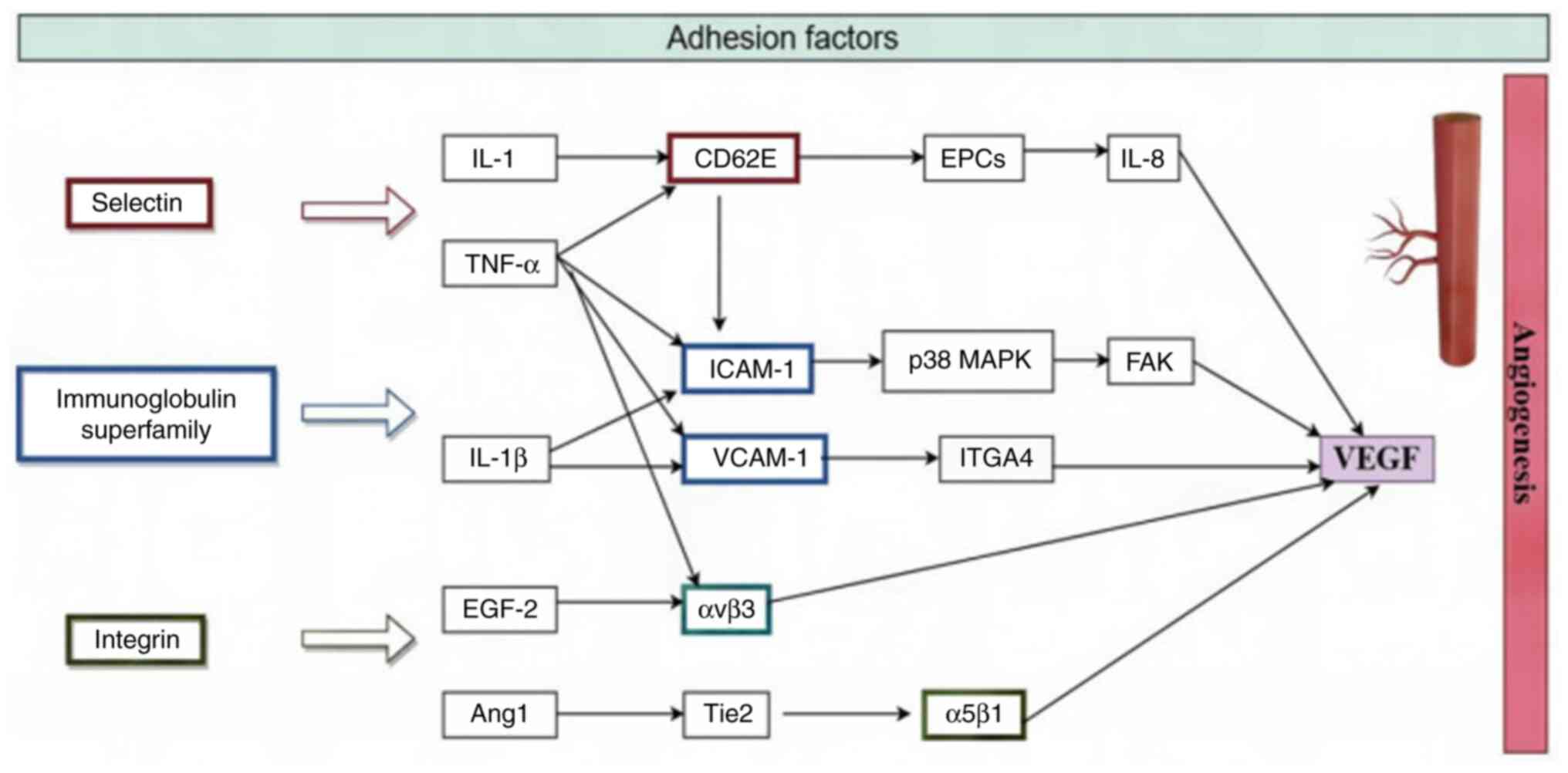|
1
|
Saini V, Guada L and Yavagal DR: Global
epidemiology of stroke and access to acute ischemic stroke
interventions. Neurology. 97 (Suppl 2):S6–S16. 2021.PubMed/NCBI View Article : Google Scholar
|
|
2
|
Zhu L, Wang M, Liu Y, Fu P, Zhang W, Zhang
H, Roe AW and Xi W: Single-microvessel occlusion produces
lamina-specific microvascular flow vasodynamics and signs of
neurodegenerative change. Cell Rep. 42(112469)2023.PubMed/NCBI View Article : Google Scholar
|
|
3
|
Krupinski J, Kaluza J, Kumar P, Kumar S
and Wang JM: Role of angiogenesis in patients with cerebral
ischemic stroke. Stroke. 25:1794–1798. 1994.PubMed/NCBI View Article : Google Scholar
|
|
4
|
Kim JJ, Kim DH, Lee JY, Lee BC, Kang I,
Kook MG, Kong D, Choi SW, Woo HM, Kim DI and Kang KS: cAMP/EPAC
signaling enables ETV2 to induce endothelial cells with high
angiogenesis potential. Mol Ther. 28:466–478. 2020.PubMed/NCBI View Article : Google Scholar
|
|
5
|
Tamargo IA, Baek KI, Kim Y, Park C and Jo
H: Flow-induced reprogramming of endothelial cells in
atherosclerosis. Nat Rev Cardiol. 20:738–753. 2023.PubMed/NCBI View Article : Google Scholar
|
|
6
|
Cartland SP, Patil MS, Kelland E, Le N,
Boccanfuso L, Stanley CP, Cholan PM, Dona MI, Patrick R, McGrath J,
et al: The generation of stable microvessels in ischemia is
mediated by endothelial cell derived TRAIL. Sci Adv.
10(eadn8760)2024.PubMed/NCBI View Article : Google Scholar
|
|
7
|
Wei C, Jiang W, Wang R, Zhong H, He H, Gao
X, Zhong S, Yu F, Guo Q, Zhang L, et al: Brain endothelial GSDMD
activation mediates inflammatory BBB breakdown. Nature.
629:893–900. 2024.PubMed/NCBI View Article : Google Scholar
|
|
8
|
Yan F, Liu X, Ding H and Zhang W:
Paracrine mechanisms of endothelial progenitor cells in vascular
repair. Acta Histochem. 124(151833)2022.PubMed/NCBI View Article : Google Scholar
|
|
9
|
Oh IY, Yoon CH, Hur J, Kim JH, Kim TY, Lee
CS, Park KW, Chae IH, Oh BH, Park YB and Kim HS: Involvement of
E-selectin in recruitment of endothelial progenitor cells and
angiogenesis in ischemic muscle. Blood. 110:3891–3899.
2007.PubMed/NCBI View Article : Google Scholar
|
|
10
|
Resnikoff HA and Schwarzbauer JE:
Increased basal fibronectin is sufficient to promote excess
endothelial cell matrix assembly causing localized barrier
dysfunction. Mol Biol Cell. 35(ar120)2024.PubMed/NCBI View Article : Google Scholar
|
|
11
|
Hildbrand P, Cirulli V, Prinsen RC, Smith
KA, Torbett BE, Salomon DR and Crisa L: The role of angiopoietins
in the development of endothelial cells from cord blood CD34+
progenitors. Blood. 104:2010–2019. 2004.PubMed/NCBI View Article : Google Scholar
|
|
12
|
Heinisch PP, Bello C, Emmert MY, Carrel T,
Dreßen M, Hörer J, Winkler B and Luedi MM: Endothelial progenitor
cells as biomarkers of cardiovascular pathologies: A narrative
review. Cells. 11(1678)2022.PubMed/NCBI View Article : Google Scholar
|
|
13
|
Sultan I, Ramste M, Peletier P,
Hemanthakumar KA, Ramanujam D, Tirronen A, von Wright Y, Antila S,
Saharinen P, Eklund L, et al: Contribution of VEGF-B-Induced
endocardial endothelial cell lineage in physiological versus
pathological cardiac hypertrophy. Circ Res. 134:1465–1482.
2024.PubMed/NCBI View Article : Google Scholar
|
|
14
|
Jaakkola P, Mole DR, Tian YM, Wilson MI,
Gielbert J, Gaskell SJ, von Kriegsheim A, Hebestreit HF, Mukherji
M, Schofield CJ, et al: Targeting of HIF-alpha to the von
hippel-lindau ubiquitylation complex by O2-regulated prolyl
hydroxylation. Science. 292:468–472. 2001.PubMed/NCBI View Article : Google Scholar
|
|
15
|
Cha S, Kim HG, Jang H, Lee J, Chao T, Baek
NI, Song IS and Lee YM: Steppogenin suppresses tumor growth and
sprouting angiogenesis through inhibition of HIF-1α in tumors and
DLL4 activity in the endothelium. Phytomedicine.
108(154513)2023.PubMed/NCBI View Article : Google Scholar
|
|
16
|
Qin C, Yang S, Chu YH, Zhang H, Pang XW,
Chen L, Zhou LQ, Chen M, Tian DS and Wang W: Signaling pathways
involved in ischemic stroke: Molecular mechanisms and therapeutic
interventions. Signal Transduct Target Ther. 7(215)2022.PubMed/NCBI View Article : Google Scholar
|
|
17
|
Chen X, Qian W, Zhang Y, Zhao P, Lin X,
Yang S, Zhuge Q and Ni H: Ginsenoside CK cooperates with bone
mesenchymal stem cells to enhance angiogenesis post-stroke via
GLUT1 and HIF-1α/VEGF pathway. Phytother Res. 38:4321–4335.
2024.PubMed/NCBI View
Article : Google Scholar
|
|
18
|
Patra K, Jana S, Sarkar A, Mandal DP and
Bhattacharjee S: The inhibition of hypoxia-induced angiogenesis and
metastasis by cinnamaldehyde is mediated by decreasing HIF-1α
protein synthesis via PI3K/Akt pathway. Biofactors. 45:401–415.
2019.PubMed/NCBI View Article : Google Scholar
|
|
19
|
Chen X, Fu K, Lai Y, Dong C, Chen Z, Huang
Y, Li G, Jiang R, Wu H, Wang A, et al: Tetrahydropalmatine:
Orchestrating survival-Regulating autophagy and apoptosis via the
PI3K/AKT/mTOR pathway in perforator flaps. Biomed Pharmacother.
169(115887)2023.PubMed/NCBI View Article : Google Scholar
|
|
20
|
Amin N, Chen S, Ren Q, Tan X, Botchway
BOA, Hu Z, Chen F, Ye S, Du X, Chen Z and Fang M: Hypoxia inducible
factor-1α attenuates ischemic brain damage by modulating
inflammatory response and glial activity. Cells.
10(1359)2021.PubMed/NCBI View Article : Google Scholar
|
|
21
|
Jeong H, Choi D, Oh Y, Heo J and Hong J: A
Nanocoating co-localizing nitric oxide and growth factor onto
individual endothelial cells reveals synergistic effects on
angiogenesis. Adv Healthc Mater. 11(e2102095)2022.PubMed/NCBI View Article : Google Scholar
|
|
22
|
Wu DM, Liu JP, Liu J, Ge WH, Wu SZ, Zeng
CJ, Liang J, Liu K, Lin Q, Hong XW, et al: Immune pathway
activation in neurons triggers neural damage after stroke. Cell
Rep. 42(113368)2023.PubMed/NCBI View Article : Google Scholar
|
|
23
|
Di Santo C, La Russa D, Greco R, Persico
A, Zanaboni AM, Bagetta G and Amantea D: Characterization of the
involvement of tumour necrosis factor (TNF)-α-stimulated gene 6
(TSG-6) in ischemic brain injury caused by middle cerebral artery
occlusion in mouse. Int J Mol Sci. 24(5800)2023.PubMed/NCBI View Article : Google Scholar
|
|
24
|
Nouri Barkestani M, Shamdani S, Afshar
Bakshloo M, Arouche N, Bambai B, Uzan G and Naserian S: TNFα
priming through its interaction with TNFR2 enhances endothelial
progenitor cell immunosuppressive effect: new hope for their
widespread clinical application. Cell Commun Signal.
19(1)2021.PubMed/NCBI View Article : Google Scholar
|
|
25
|
Zhao ZA, Yan L, Wen J, Satyanarayanan SK,
Yu F, Lu J, Liu YU and Su H: Cellular and molecular mechanisms in
vascular repair after traumatic brain injury: A narrative review.
Burns Trauma. 11(tkad033)2023.PubMed/NCBI View Article : Google Scholar
|
|
26
|
Yu Z, Witman N, Wang W, Li D, Yan B, Deng
M, Wang X, Wang H, Zhou G, Liu W, et al: Cell-mediated delivery of
VEGF modified mRNA enhances blood vessel regeneration and
ameliorates murine critical limb ischemia. J Control Release.
310:103–114. 2019.PubMed/NCBI View Article : Google Scholar
|
|
27
|
Luís JP, Simões CJV and Brito RMM: The
therapeutic prospects of targeting IL-1R1 for the modulation of
neuroinflammation in central nervous system disorders. Int J Mol
Sci. 23(1731)2022.PubMed/NCBI View Article : Google Scholar
|
|
28
|
Riddle RB, Jennbacken K, Hansson KM and
Harper MT: Endothelial inflammation and neutrophil transmigration
are modulated by extracellular matrix composition in an
inflammation-on-a-chip model. Sci Rep. 12(6855)2022.PubMed/NCBI View Article : Google Scholar
|
|
29
|
Saini MG and Bix GJ: Oxygen-glucose
deprivation (OGD) and interleukin-1 (IL-1) differentially modulate
cathepsin B/L mediated generation of neuro protective perlecan LG3
by neurons. Brain Res. 1438:65–74. 2012.PubMed/NCBI View Article : Google Scholar
|
|
30
|
Parham CL, Shaw C, Auckland LD, Dickeson
SK, Griswold-Prenner I and Bix G: Perlecan Domain V inhibits
amyloid-β induced activation of the α2β1 integrin-mediated
neurotoxic signaling cascade. J Alzheimers Dis. 54:1629–1647.
2016.PubMed/NCBI View Article : Google Scholar
|
|
31
|
Rajkovic I, Wong R, Lemarchand E,
Rivers-Auty J, Rajkovic O, Garlanda C, Allan SM and Pinteaux E:
Pentraxin 3 promotes long-term cerebral blood flow recovery,
angiogenesis, and neuronal survival after stroke. J Mol Med (Berl).
96:1319–1332. 2018.PubMed/NCBI View Article : Google Scholar
|
|
32
|
Bayat M, Tabrizi R, Saied Salehi M, Karimi
N, Rahimi M, Hooshmandi E, Razavi Moosavi N, Fadakar N and
Borhani-Haghighi A: Association of long non-coding RNA malat1 with
serum levels of interleukin-1 Β and vitamin D in patients with
ischemic stroke. Galen Med J. 12:1–10. 2023.PubMed/NCBI View Article : Google Scholar
|
|
33
|
Takata F, Nakagawa S, Matsumoto J and
Dohgu S: Blood-brain barrier dysfunction amplifies the development
of neuroinflammation: understanding of cellular events in brain
microvascular endothelial cells for prevention and treatment of BBB
dysfunction. Front Cell Neurosci. 15(661838)2021.PubMed/NCBI View Article : Google Scholar
|
|
34
|
Mantsounga CS, Lee C, Neverson J, Sharma
S, Healy A, Berus JM, Parry C, Ceneri NM, López-Giráldez F, Chun
HJ, et al: Macrophage IL-1β promotes arteriogenesis by autocrine
STAT3- and NF-κB-mediated transcription of pro-angiogenic VEGF-A.
Cell Rep. 38(110309)2022.PubMed/NCBI View Article : Google Scholar
|
|
35
|
Yamasaki Y, Matsuura N, Shozuhara H,
Onodera H, Itoyama Y and Kogure K: Interleukin-1 as a pathogenetic
mediator of ischemic brain damage in rats. Stroke. 26:676–80;
discussion 681. 1995.PubMed/NCBI View Article : Google Scholar
|
|
36
|
Matys P, Mirończuk A, Starosz A, Grubczak
K, Kochanowicz J, Kułakowska A and Kapica-Topczewska K: Expanding
role of interleukin-1 family cytokines in acute ischemic stroke.
Int J Mol Sci. 25(10515)2024.PubMed/NCBI View Article : Google Scholar
|
|
37
|
Scheller J, Ettich J, Wittich C, Pudewell
S, Floss DM and Rafii P: Exploring the landscape of synthetic
IL-6-type cytokines. FEBS J. 291:2030–2050. 2024.PubMed/NCBI View Article : Google Scholar
|
|
38
|
Akira S, Nishio Y, Inoue M, Wang XJ, Wei
S, Matsusaka T, Yoshida K, Sudo T, Naruto M and Kishimoto T:
Molecular cloning of APRF, a novel IFN-stimulated gene factor 3
p91-related transcription factor involved in the gp130-mediated
signaling pathway. Cell. 77:63–71. 1994.PubMed/NCBI View Article : Google Scholar
|
|
39
|
Sakata H, Narasimhan P, Niizuma K, Maier
CM, Wakai T and Chan PH: Interleukin 6-preconditioned neural stem
cells reduce ischaemic injury in stroke mice. Brain. 135:3298–3310.
2012.PubMed/NCBI View Article : Google Scholar
|
|
40
|
Monsour M, Croci DM, Agazzi S and
Borlongan CV: Contemplating IL-6, a double-edged sword cytokine:
Which side to use for stroke pathology. CNS Neurosci Ther.
29:493–497. 2023.PubMed/NCBI View Article : Google Scholar
|
|
41
|
Cohen T, Nahari D, Cerem LW, Neufeld G and
Levi BZ: Interleukin 6 induces the expression of vascular
endothelial growth factor. J Biol Chem. 271:736–741.
1996.PubMed/NCBI View Article : Google Scholar
|
|
42
|
Ley K: The role of selectins in
inflammation and disease. Trends Mol Med. 9:263–268.
2003.PubMed/NCBI View Article : Google Scholar
|
|
43
|
Choi BR, Johnson KR, Maric D and McGavern
DB: Monocyte-derived IL-6 programs microglia to rebuild damaged
brain vasculature. Nat Immunol. 24:1110–1123. 2023.PubMed/NCBI View Article : Google Scholar
|
|
44
|
Frijns CJ and Kappelle LJ: Inflammatory
cell adhesion molecules in ischemic cerebrovascular disease.
Stroke. 33:2115–2122. 2002.PubMed/NCBI View Article : Google Scholar
|
|
45
|
Cheng D and Wang Y, Li J, Yao Y, Zhang S
and Wang Y: Transcriptomic analysis identifies the S100
calcium-binding protein β subunit (S100B) and intercellular
adhesion molecule-1 (ICAM-1) as potential diagnostic biomarkers for
acute cerebral infarction. Genes Dis. 11:46–48. 2023.PubMed/NCBI View Article : Google Scholar
|
|
46
|
Henninger DD, Panés J, Eppihimer M,
Russell J, Gerritsen M, Anderson DC and Granger DN:
Cytokine-induced VCAM-1 and ICAM-1 expression in different organs
of the mouse. J Immunol. 158:1825–1832. 1997.PubMed/NCBI
|
|
47
|
Kim I, Moon SO, Kim SH, Kim HJ, Koh YS and
Koh GY: Vascular endothelial growth factor expression of
intercellular adhesion molecule 1 (ICAM-1), vascular cell adhesion
molecule 1 (VCAM-1), and E-selectin through nuclear factor-kappa B
activation in endothelial cells. J Biol Chem. 276:7614–7620.
2001.PubMed/NCBI View Article : Google Scholar
|
|
48
|
Rüegg C, Postigo AA, Sikorski EE, Butcher
EC, Pytela R and Erle DJ: Role of integrin alpha 4 beta 7/alpha 4
beta P in lymphocyte adherence to fibronectin and VCAM-1 and in
homotypic cell clustering. J Cell Biol. 117:179–189.
1992.PubMed/NCBI View Article : Google Scholar
|
|
49
|
Langston W, Chidlow JH Jr, Booth BA,
Barlow SC, Lefer DJ, Patel RP and Kevil CG: Regulation of
endothelial glutathione by ICAM-1 governs VEGF-A-mediated eNOS
activity and angiogenesis. Free Radic Biol Med. 42:720–729.
2007.PubMed/NCBI View Article : Google Scholar
|
|
50
|
Nakao S, Kuwano T, Ishibashi T, Kuwano M
and Ono M: Synergistic effect of TNF-alpha in soluble
VCAM-1-induced angiogenesis through alpha 4 integrins. J Immunol.
170:5704–5711. 2003.PubMed/NCBI View Article : Google Scholar
|
|
51
|
Ibli SI, Hu J, Looso M, Weigert A, Ratiu
C, Wittig J, Drekolia MK, Tombor L, Randriamboavonjy V, Leisegang
MS, et al: Mapping the endothelial cell S-sulfhydrome highlights
the crucial role of integrin sulfhydration in vascular function.
Circulation. 143:935–948. 2021.PubMed/NCBI View Article : Google Scholar
|
|
52
|
Bi JJ and Yi L: Effects of integrins and
integrin αvβ3 inhibitor on angiogenesis in cerebral ischemic
stroke. J Huazhong Univ Sci Technolog Med Sci. 34:299–305.
2014.PubMed/NCBI View Article : Google Scholar
|
|
53
|
Huang Q, Chen B, Wang F, Huang H, Milner R
and Li L: The temporal expression patterns of fibronectin and its
receptors-α5β1 and αvβ3 integrins on blood vessels after cerebral
ischemia. Restor Neurol Neurosci. 33:493–507. 2015.PubMed/NCBI View Article : Google Scholar
|
|
54
|
Pang D, Wang L, Dong J, Lai X, Huang Q,
Milner R and Li L: Integrin α5β1-Ang1/Tie2 receptor cross-talk
regulates brain endothelial cell responses following cerebral
ischemia. Exp Mol Med. 50:1–12. 2018.PubMed/NCBI View Article : Google Scholar
|
|
55
|
Zhang X, Wang L, Han Z, Dong J, Pang D, Fu
Y and Li L: KLF4 alleviates cerebral vascular injury by
ameliorating vascular endothelial inflammation and regulating tight
junction protein expression following ischemic stroke. J
Neuroinflammation. 17(107)2020.PubMed/NCBI View Article : Google Scholar
|
|
56
|
Jeucken KCM, van Rooijen CCN, Kan YY,
Kocken LA, Jongejan A, van Steen ACI, van Buul JD, Olsson HK, van
Hamburg JP and Tas SW: Differential contribution of NF-κB signaling
pathways to CD4+ Memory T cell induced activation of endothelial
cells. Front Immunol. 13(860327)2022.PubMed/NCBI View Article : Google Scholar
|
|
57
|
Xie Y, Sun Y, Liu Y, Zhao J, Liu Q, Xu J,
Qin Y, He R, Yuan F, Wu T, et al: Targeted delivery of
RGD-CD146+CD271+ human umbilical cord
mesenchymal stem cell-derived exosomes promotes blood-spinal cord
barrier repair after spinal cord injury. ACS Nano. 17:18008–18024.
2023.PubMed/NCBI View Article : Google Scholar
|
|
58
|
Lin Y, Gil CH, Banno K, Yokoyama M, Wingo
M, Go E, Prasain N, Liu Y, Hato T, Naito H, et al: ABCG2-expressing
clonal repopulating endothelial cells serve to form and maintain
blood vessels. Circulation. 150:451–465. 2024.PubMed/NCBI View Article : Google Scholar
|
|
59
|
Wang L, Li J, Wang Y, Ge C, Huang Q, Li L,
Wang N, Chen Y, Zhou X, Chang D, et al: Dan-Deng-Tong-Nao softgel
capsule promotes angiogenesis of cerebral microvasculature to
protect cerebral ischemia reperfusion injury via activating
HIF-1α-VEGFA-Notch1 signaling pathway. Phytomedicine.
118(154966)2023.PubMed/NCBI View Article : Google Scholar
|
|
60
|
Ran X, Xu T, Ruan H, Wang X and Zhang Q:
Tissue Kallikrein supplementation in ischemic phase protects the
neurovascular unit and attenuates reperfusion-induced injury in
ischemic stroke. Pharmacol Res. 209(107435)2024.PubMed/NCBI View Article : Google Scholar
|
|
61
|
Peiretti F, Alessi MC, Henry M, Anfosso F,
Juhan-Vague I and Nalbone G: Intracellular calcium mobilization
suppresses the TNF-alpha-stimulated synthesis of PAI-1 in human
endothelial cells. Indications that calcium acts at a translational
level. Arterioscler Thromb Vasc Biol. 17:1550–1560. 1997.PubMed/NCBI View Article : Google Scholar
|
|
62
|
Panthiya L, Tocharus J, Onsa-Ard A,
Chaichompoo W, Suksamrarn A and Tocharus C: Hexahydrocurcumin
ameliorates hypertensive and vascular remodeling in L-NAME-induced
rats. Biochim Biophys Acta Mol Basis Dis.
1868(166317)2022.PubMed/NCBI View Article : Google Scholar
|
|
63
|
Zhang G, Qin Q, Zhang C, Sun X, Kazama K,
Yi B, Cheng F, Guo ZF and Sun J: NDRG1 signaling is essential for
endothelial inflammation and vascular remodeling. Circ Res.
132:306–319. 2023.PubMed/NCBI View Article : Google Scholar
|
|
64
|
Bischoff-Kont I, Primke T, Niebergall LS,
Zech T and Fürst R: Ginger constituent 6-shogaol inhibits
inflammation- and angiogenesis-related cell functions in primary
human endothelial cells. Front Pharmacol. 13(844767)2022.PubMed/NCBI View Article : Google Scholar
|















